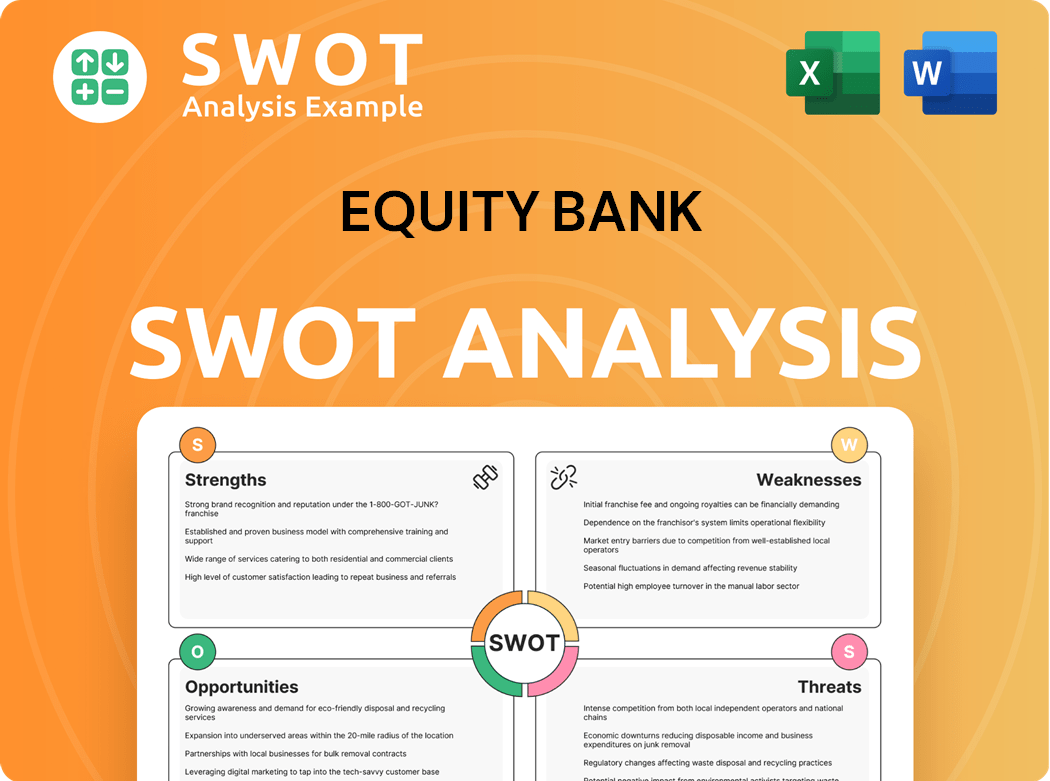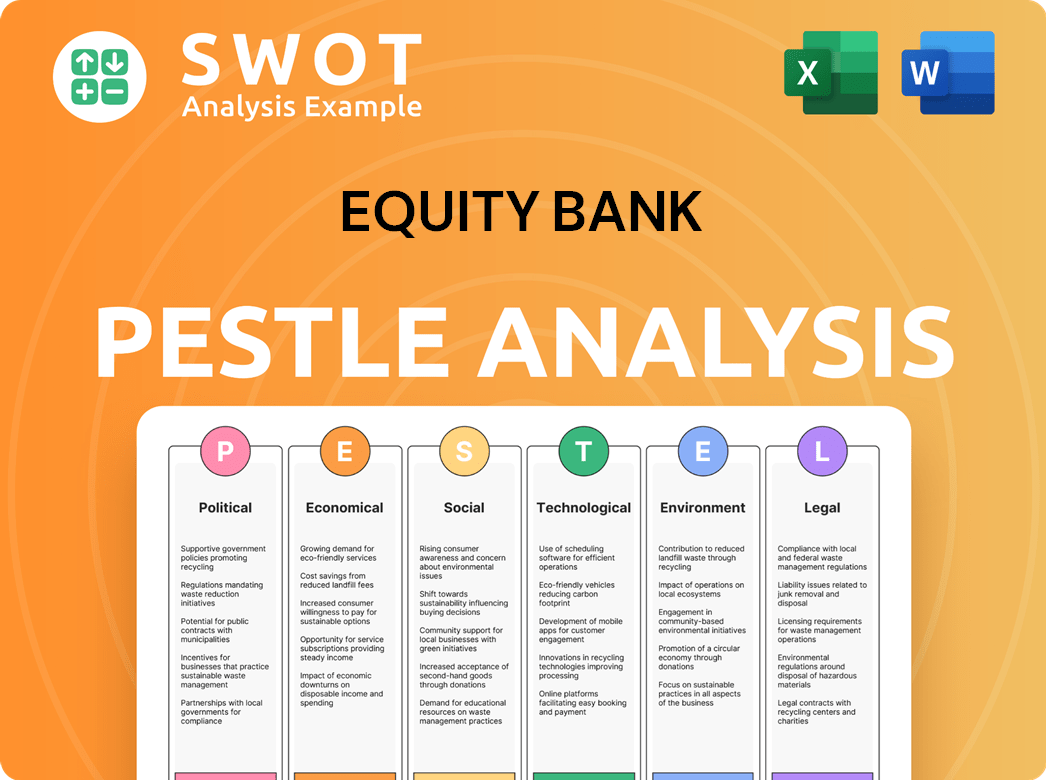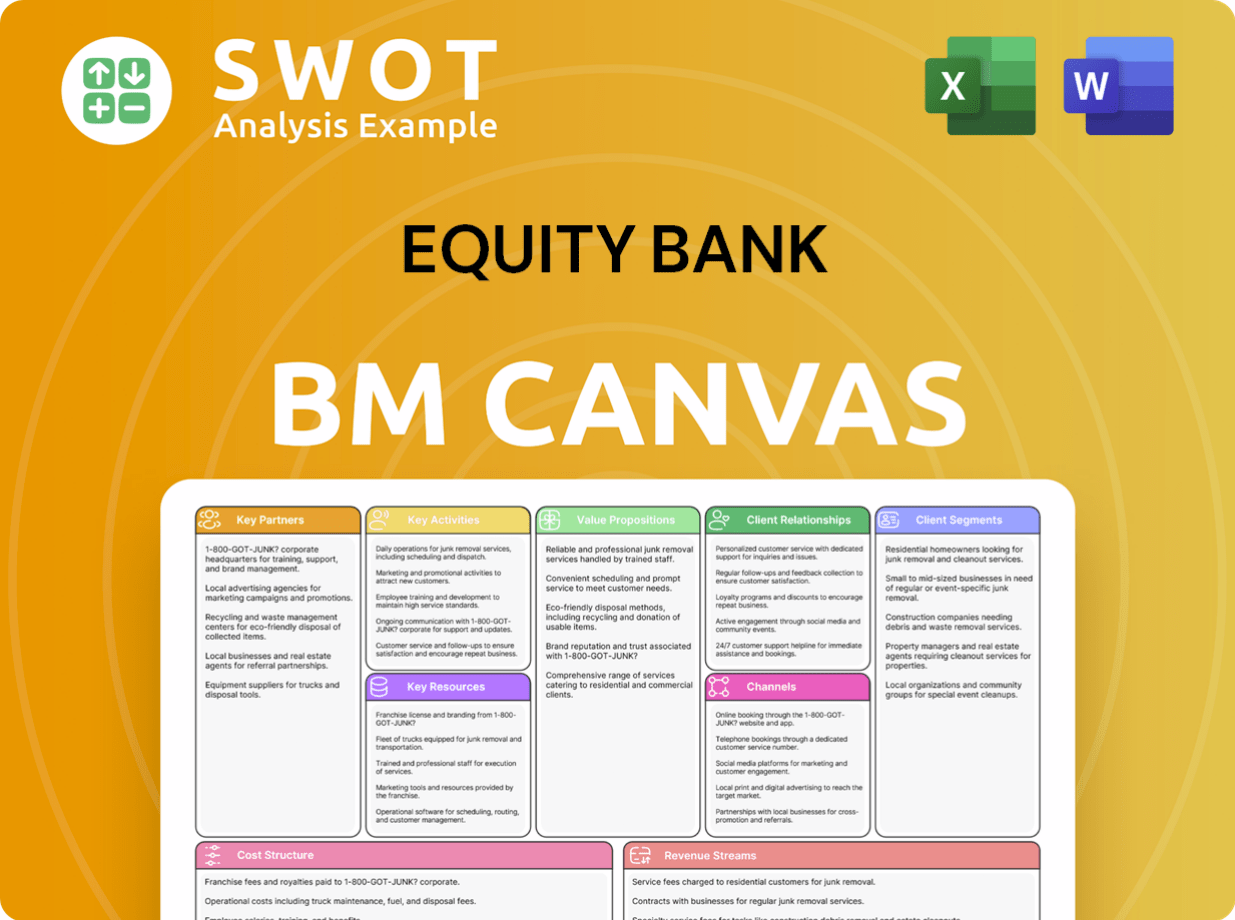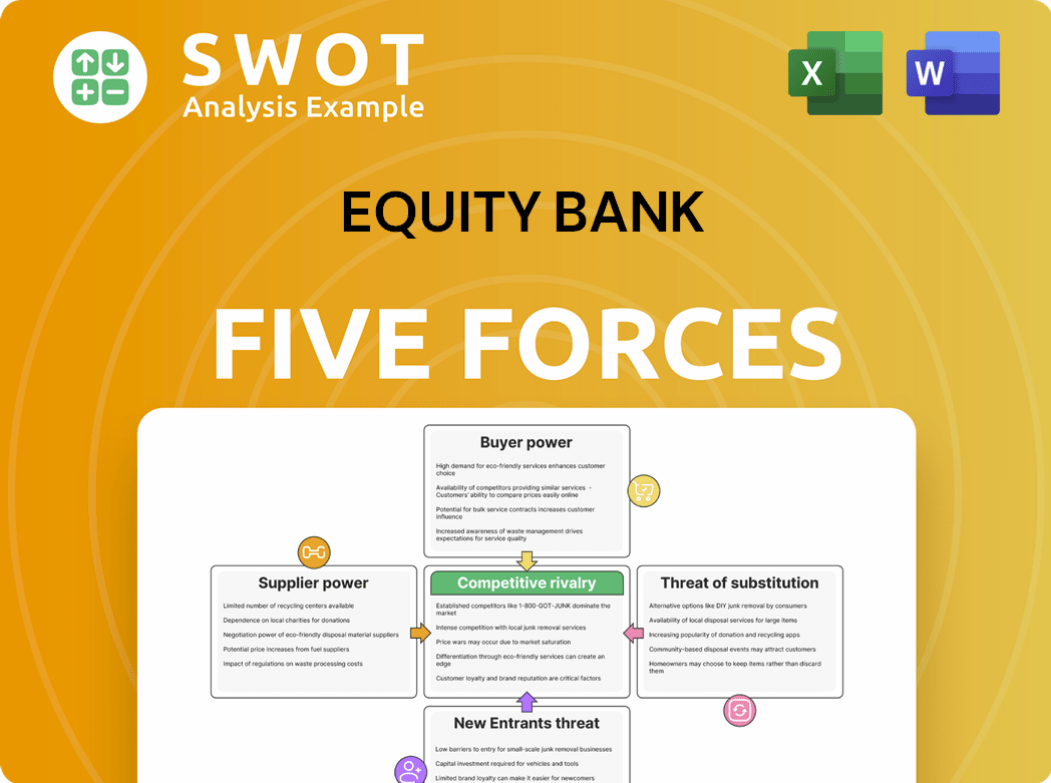Equity Bank Bundle
How Does Equity Bank Navigate the Shifting Banking Sector?
The banking sector in 2025 is a battlefield of geopolitical uncertainty, economic volatility, and rapid technological change. Banks are adapting, but success requires a deep understanding of the competitive landscape. Equity Bank SWOT Analysis offers a glimpse into this dynamic environment.

Equity Bank, founded in 2002, has strategically expanded across Kansas, Missouri, Arkansas, and Oklahoma, offering a comprehensive suite of financial services. Understanding the Equity Bank competitive landscape, including its rivals and market position, is critical. This analysis delves into Equity Bank's strategic responses to market trends, providing actionable insights for stakeholders. The Kenyan banking sector and Equity Group Holdings are also considered.
Where Does Equity Bank’ Stand in the Current Market?
Equity Bancshares, Inc. holds a strong market position, particularly in Kansas, Missouri, Arkansas, and Oklahoma. The company operates approximately 74 locations within these regions, focusing on providing comprehensive financial services to its customers.
In the first quarter of 2025, Equity Bancshares demonstrated solid financial performance. The company reported a net income of $15 million, translating to $0.85 per diluted share. Furthermore, the net interest income reached $50.3 million, with a net interest margin of 4.27%.
Equity Bank's financial health is reflected in its capital ratios. The common equity tier 1 capital to risk-weighted assets ratio was 14.7%, and the total capital to risk-weighted assets ratio was 18.3% as of March 31, 2025. These figures indicate a well-capitalized financial institution.
The bank offers a variety of services, including commercial loans, consumer banking, and mortgage loans. Additionally, Equity Bank provides trust and wealth management services, along with treasury management solutions. Online and mobile banking solutions are also available, such as online transfers and bill payments.
The acquisition of NBC Corp. of Oklahoma is set to strengthen Equity Bank's presence. This acquisition, expected to add approximately $900 million in assets, aligns with the bank's strategy of organic growth and strategic mergers and acquisitions.
Equity Group, a related entity, has been recognized as the 2nd strongest banking brand globally by Brand Finance. This recognition underscores the strong brand reputation within its operating regions. For more details on their strategic initiatives, you can refer to the Growth Strategy of Equity Bank.
Equity Bank's financial health is indicated by its strong capital ratios. The tangible common equity (TCE) ratio was 10.13% at March 31, 2025, marking a 36% increase year-over-year. The tangible book value per share was $31.07, up 24% from Q1 2024.
- Net income of $15 million in Q1 2025.
- Net interest income of $50.3 million in Q1 2025.
- Tangible common equity (TCE) ratio of 10.13% at March 31, 2025.
- Total capital to risk-weighted assets ratio of 18.3% at March 31, 2025.
Equity Bank SWOT Analysis
- Complete SWOT Breakdown
- Fully Customizable
- Editable in Excel & Word
- Professional Formatting
- Investor-Ready Format

Who Are the Main Competitors Challenging Equity Bank?
The Brief History of Equity Bank reveals a competitive landscape shaped by both direct and indirect rivals. Equity Bancshares, Inc. faces competition from various financial institutions within the regions it operates. This includes regional and community banks, as well as larger financial institutions and emerging fintech companies. Understanding the Equity Bank competitive landscape is crucial for assessing its market position and future prospects.
The competitive dynamics are influenced by factors such as economies of scale, product offerings, and technological investments. The banking sector's consolidation trend, with mergers and acquisitions, further intensifies competition. The rise of fintech companies offering innovative digital solutions also poses a challenge. This analysis is essential for investors and stakeholders interested in the Kenyan banking sector and the broader banking industry analysis.
Equity Bank's main rivals in Kenya and other regions include a mix of established and emerging players. The competitive analysis of Equity Bank's financial performance is critical for understanding its standing in the market. The market share of Equity Bank compared to other banks is a key indicator of its success. Equity Bank's strategic advantages and disadvantages, along with a comparison to competitors like KCB Group, are crucial for a comprehensive evaluation.
Equity Bank's direct competitors include regional and community banks. These banks operate within the same geographic areas, such as Kansas, Missouri, Arkansas, and Oklahoma. Specific market share figures are not always readily available for direct comparisons.
Some of the primary competitors include Bank of Marin, Mercantile Bank, and Heritage Bank of Commerce. These banks compete directly with Equity Bank for customers and market share. The competitive landscape also includes larger financial institutions.
Indirect competitors include larger financial institutions and emerging fintech companies. These entities challenge Equity Bank through economies of scale, extensive product offerings, and technology investments. Fintechs disrupt the traditional banking model with digital solutions.
In the broader financial services industry, Scotiabank, Rawbank, and BCDC are top competitors, particularly in Kinshasa, Congo. This highlights the diversified competitive pressures Equity Bank faces across its operational footprints. New players in areas like Buy Now Pay Later (BNPL) also pose indirect competition.
In the Kenyan market, Equity Bank competes with BNPL providers. These include companies like Lipa Later, M-Kopa, Tala, and Branch. These companies offer alternative financial solutions, impacting Equity Bank's customer base.
The banking sector is experiencing consolidation through mergers and acquisitions. This trend increases competition from larger, more consolidated entities. Equity Bank may also engage in acquisitions to expand its market reach and enhance its competitive position.
Several factors shape Equity Bank's competitive landscape. These include the impact of regulations on competition and Equity Bank's customer acquisition strategies compared to competitors. The analysis should consider Equity Bank's expansion plans and competitive implications, as well as its profitability compared to competitors. Understanding Equity Bank's strengths and weaknesses is crucial.
- Market Share: Analyzing market share data provides insights into Equity Bank's position relative to its competitors.
- Product Offerings: Comparing the range of financial products and services offered by Equity Bank and its rivals.
- Digital Banking: Assessing Equity Bank's investment in technology and its competitive edge in digital banking.
- Customer Base: Evaluating Equity Bank's customer acquisition strategies and customer satisfaction levels.
- Financial Performance: Reviewing Equity Bank's profitability, revenue growth, and cost efficiency compared to competitors.
Equity Bank PESTLE Analysis
- Covers All 6 PESTLE Categories
- No Research Needed – Save Hours of Work
- Built by Experts, Trusted by Consultants
- Instant Download, Ready to Use
- 100% Editable, Fully Customizable

What Gives Equity Bank a Competitive Edge Over Its Rivals?
Understanding the competitive landscape of Equity Bank involves assessing its key strengths and strategic positioning within the financial sector. Equity Bank, like other players in the banking industry, faces a dynamic environment shaped by digital transformation, evolving customer expectations, and regulatory changes. Analyzing its competitive advantages offers insights into how it aims to maintain and enhance its market position.
Equity Bank's competitive edge is shaped by its strategic initiatives, customer-centric approach, and robust financial health. The bank's ability to adapt to digital trends, maintain strong customer relationships, and ensure financial stability are crucial for its success. By examining these factors, we can gain a clearer picture of Equity Bank's competitive strategy and its prospects in the market.
The competitive landscape of Equity Bank is influenced by its ability to leverage its strengths and adapt to market dynamics. This includes its approach to growth, customer service, and financial management, all of which contribute to its competitive advantage.
Equity Bank's growth strategy combines organic initiatives with strategic acquisitions. This approach allows the bank to expand its geographic presence and scale its operations. The acquisition of Rockhold BanCorp in Missouri and the planned merger with NBC Corp. of Oklahoma are examples of this strategy, adding approximately $900 million in assets. This strategy helps Equity Bank gain scale and expand its geographic footprint.
Equity Bank emphasizes relationship-based customer service, a hallmark of community banking. This approach fosters customer loyalty and helps differentiate the bank from competitors. This focus on customer relationships is a key element of Equity Bank's competitive strategy.
Equity Bank is investing in digital transformation to enhance customer experience and operational efficiency. While specific figures for Equity Bancshares are not detailed, Equity Group has shown strong digital adoption, with 86% of transactions processed through digital channels in 2024, increasing to 87% in Q1 2025. This includes high usage of its mobile app, USSD, and EazzyFX platform.
Equity Bank's strong financial health provides a solid foundation for investment and resilience. As of March 31, 2025, the company maintained robust capital ratios, including a common equity tier 1 capital to risk-weighted assets ratio of 14.7% and a total leverage ratio of 11.8%, both well above regulatory requirements. The company's diversified loan portfolio and efforts to improve asset quality, with nonaccrual loans and nonperforming assets decreasing in Q1 2025, further contribute to its resilience.
Equity Bank's competitive advantages are rooted in its strategic growth approach, customer-centric service, and strong financial management. These factors enable the bank to adapt to market changes and maintain a strong position in the Equity Bank competitive landscape. The bank's focus on digital transformation and its robust capital position further enhance its ability to compete effectively.
- Strategic Acquisitions: Expanding geographic presence and scale through targeted acquisitions.
- Customer-Centric Approach: Fostering customer loyalty through relationship-based service.
- Digital Transformation: Enhancing customer experience and operational efficiency through technology.
- Strong Financial Health: Maintaining robust capital ratios and a diversified loan portfolio.
Equity Bank Business Model Canvas
- Complete 9-Block Business Model Canvas
- Effortlessly Communicate Your Business Strategy
- Investor-Ready BMC Format
- 100% Editable and Customizable
- Clear and Structured Layout

What Industry Trends Are Reshaping Equity Bank’s Competitive Landscape?
The competitive landscape for Equity Bank in 2025 is shaped by significant industry trends, including rapid technological advancements and evolving customer expectations. The bank's market position is influenced by its ability to adapt to digital transformation, regulatory changes, and the rise of fintech competitors. Understanding the Equity Bank competitive landscape requires an analysis of its strategic advantages and disadvantages within the dynamic Kenyan banking sector.
Several risks and opportunities are present. Economic uncertainty and geopolitical tensions pose challenges, while opportunities arise from digital payments and embedded finance growth. The bank's future outlook depends on its capacity to manage risks and capitalize on emerging trends, as well as its response to digital banking trends.
The banking industry is experiencing rapid digital transformation, with increased investment in AI for various applications. Regulatory changes, such as the Digital Operational Resilience Act (DORA), are also impacting banks. Consumer preferences are shifting towards digital-first experiences and personalized services, influencing the competitive dynamics of the banking industry analysis.
Equity Bank faces challenges from an uncertain global economic recovery, which is expected to maintain a low growth rate of 2.6% in 2025. Higher credit losses, potentially increasing by about 7% to US$850 billion globally, and increased competition from fintechs are also significant hurdles. Geopolitical risks and cyber threats will continue to challenge business models.
Significant opportunities exist in the accelerated adoption of digital payments and embedded finance. Strategic partnerships and M&A activities are expected to rebound, allowing banks to gain scale. Equity Bank's initiatives, such as the 'Africa Recovery and Resilience Plan', offer growth potential by tapping into emerging markets.
Equity Group's 'Africa Recovery and Resilience Plan' (ARRP) is a $6 billion initiative supporting socio-economic development across Africa. This plan focuses on sectors like food and agriculture, manufacturing, and MSME lending. The bank is also investing in technology to enhance financial inclusion. For more insights, see the Target Market of Equity Bank.
The competitive landscape of Equity Bank is defined by its response to digital banking trends, customer acquisition strategies, and investment in technology. The bank's competitive strategy in the SME market and its expansion plans are also crucial. Understanding Equity Bank's main rivals in Kenya is essential for a comprehensive competitive analysis of Equity Bank's financial performance.
- Digital Transformation: Investment in AI and digital platforms for enhanced customer experience.
- Regulatory Compliance: Adapting to new regulations like DORA.
- Strategic Partnerships: Leveraging M&A and collaborations for growth.
- Customer Focus: Providing personalized services to meet evolving customer expectations.
Equity Bank Porter's Five Forces Analysis
- Covers All 5 Competitive Forces in Detail
- Structured for Consultants, Students, and Founders
- 100% Editable in Microsoft Word & Excel
- Instant Digital Download – Use Immediately
- Compatible with Mac & PC – Fully Unlocked

Related Blogs
- What are Mission Vision & Core Values of Equity Bank Company?
- What is Growth Strategy and Future Prospects of Equity Bank Company?
- How Does Equity Bank Company Work?
- What is Sales and Marketing Strategy of Equity Bank Company?
- What is Brief History of Equity Bank Company?
- Who Owns Equity Bank Company?
- What is Customer Demographics and Target Market of Equity Bank Company?
Disclaimer
All information, articles, and product details provided on this website are for general informational and educational purposes only. We do not claim any ownership over, nor do we intend to infringe upon, any trademarks, copyrights, logos, brand names, or other intellectual property mentioned or depicted on this site. Such intellectual property remains the property of its respective owners, and any references here are made solely for identification or informational purposes, without implying any affiliation, endorsement, or partnership.
We make no representations or warranties, express or implied, regarding the accuracy, completeness, or suitability of any content or products presented. Nothing on this website should be construed as legal, tax, investment, financial, medical, or other professional advice. In addition, no part of this site—including articles or product references—constitutes a solicitation, recommendation, endorsement, advertisement, or offer to buy or sell any securities, franchises, or other financial instruments, particularly in jurisdictions where such activity would be unlawful.
All content is of a general nature and may not address the specific circumstances of any individual or entity. It is not a substitute for professional advice or services. Any actions you take based on the information provided here are strictly at your own risk. You accept full responsibility for any decisions or outcomes arising from your use of this website and agree to release us from any liability in connection with your use of, or reliance upon, the content or products found herein.